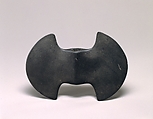Bannerstone, Double-Bitted Axe
Not on view
Made between 6000 and 1000 BCE, bannerstones are amongst the oldest finely carved lithics in the Americas. Indigenous Archaic North Americans created them from Michigan to the tip of Florida and from the Mississippi Valley over to the Atlantic coast. They carved and polished them with a peck and grind technology using a vast range of materials from soft sedimentary shale, to metamorphic slate or harder rock such as granite or quartz. Though bannerstones have been found in twenty-four different shapes, each one is a unique composition where sculptors appear to delight in the interplay of geologic characteristics in relation to the forms they sculpt. Using a hollow river reed, twisting it back and forth between their hands, adding water and sand to bite into the stone, they would drill a 1 to 2 centimeter hole down the center of the bannerstones for them to be hafted onto a shaft and hoisted to be seen. In some Archaic burials, bannerstones were found intentionally broken at the perforation where they are most fragile and carefully placed next to or on the body of the dead. This mortuary ritual use of bannerstones placed with and beside men, women, and children, attest to their importance in life and to their role in the act of mourning and remembrance. Some bannerstones were found in other burials aligned with atlatls, throwing sticks that extend the flight of a spear, leading scholars to hypothesize that they may have been hafted to atlatls as accessories or weights. Many bannerstones are far too large or small to be used in this manner leaving open the question of why they were only made in the Archaic period in Eastern North America and ceased to be made after 1000 BCE when atlatl use would continue for several centuries before the advent of the bow and arrow. Many bannerstones were found in areas at great distances from the geologic origin of the stone, revealing deep interest in stone texture and color and long distance travel and trade amongst Archaic sculptors. Whatever their purpose, the thousands of bannerstones in private and public collections are testament to the importance of stone for individual aesthetic expression during the Archaic Period in North America.
The Archaic sculptor chose soft sedimentary shale to carve this Double-Bitted Axe bannerstone. Thinning the curved edges to a millimeter in width, this bannerstone is exceedingly fragile. Parallel to the perforation they carved a pointed edge on both sides, accentuating the near perfect symmetry of the composition. On one side the ridge has chipped in what could be archaic or historic period wear. The perforation is masterfully drilled with a hollow reed leaving noticeable even concentric circles on the inside. Though there are a few chips on the thin edges of the stone, there is no sign of wear at the perforation. Given the unusually soft geologic material and thin flanges of this stone, this carefully sculpted bannerstone may have been intended for extraordinary rather than everyday display. The Museum’s accession number for this object, 2011.254.13, is written in red on one of the curved edges.
Anna Blume, Professor of the History of Art, Fashion Institute of Technology, State University of New York 2023
References and Further Reading
Knoblock, Byron. Bannerstones of the North American Indian. LaGrange: LeGrange: Bryon Knoblock, 1939.
Sassaman, Kenneth. “Craftworks of Structure.” The Eastern Archaic Historicized. New York: AltaMira Press, 2010, pp. 97-142.
The Archaic Bannerstone Project. Fashion Institute of Technology, https://bannerstone.fitnyc.edu/
Webb, William S., “Indian Knoll, Site Oh2, Ohio County, Kentucky,” Reports in Anthropology and Archaeology 4, no. 2 (1946): 115-365.
Lutz, David L. The Archaic Bannerstone: Its Chronological History and Purpose From 6000 B.C. to 1000 B.C. Newburg: David L. Lutz, 2000.
Due to rights restrictions, this image cannot be enlarged, viewed at full screen, or downloaded.


